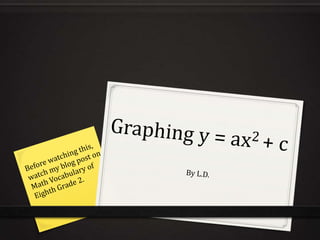
Graphing y = ax^2 + c
- 2. Problems 0 Problem 1: Graph y = x2 0 Problem 2: Graph y = 2x2 0 Problem 3: Graph y = ½x2 0 Problem 4: Graph y = -x2 0 Problem 5: Graph y = x2 - 4 0 Problem 6: Graph y = -x2 - 2 0 Problem 7: Graph y = 2x2 - 4
- 3. Problem 1 0 Graph y = x2
- 4. Problem 1 0 Graph y = x2 The first thing we need to do is to remember the x and y table we used to make for y = mx + b. We will do this on the below table always using the numbers -2, -1, 0, 1, 2. X Y On the next page you will see how the table looks completed. Our -2 problem is y = x2. We will do the -1 problem by taking a number on the side of the x and place it in the x 0 place of the problem. The answer of 1 this will go in the y problem place. 2
- 5. Problem 1 0 Graph y = x2 X Y Now we need to graph the -2 4 problem. We will make our -1 1 marking points using the x in the 0 0 x axis and the y in the y axis. The 1 1 graph will be on the next page. 2 4
- 6. Now we need to find the axis of symmetry (my graph is not perfect, so we must imagine it is completely equal in its line lengths) and the vertex.
- 7. The vertex is green. This is We must remember that the the vertex because it is the axis of symmetry is the line lowest part of the graph that splits the graph that does not go onward. If completely in the parabola was flipped half, imagining my graph then the vertex would be was perfect, our axis of the highest part because it symmetry would be directly wouldn’t have lines going in the middle. From now on onward. From now on this this presentation I shall presentation I shall make make the axis of symmetry the vertex green. purple.
- 8. Problem 2 0 Graph y = 2x2
- 9. Problem 2 0 Graph y = 2x2 Now we must use our table again and get points which we will plot. X Y -2 -1 0 1 2
- 10. Problem 2 0 Graph y = 2x2 Now we must graph this and find the vertex and axis of symmetry. X Y -2 8 -1 1 0 0 1 1 2 8
- 13. Problem 3 0 Graph y = ½x2
- 14. Problem 3 0 Graph y = ½x2 We will again use the table and then graph. We will find the vertex and axis of symmetry again. X Y X Y -2 -2 4 -1 -1 ½ 0 0 0 1 1 ½ 2 2 4
- 17. Mini Lesson There is no such thing as negative 0. If you were to have a problem like –(0)2. The answer would not be -0, but only 0 as zero trumps all.
- 18. Problem 4 0 Graph y = -x2
- 19. Problem 4 0 Graph y = -x2 Now we need to make a table again, and then find the vertex and line of symmetry. X Y When you replace the x and put a number in its place we -2 will make the problem (using -1 r as an example) look like – 0 (r)2. We will remember PEMDAS as we do this. 1 2
- 20. Problem 4 0 Graph y = -x2 Now we need to make a table again, and then find the vertex and line of symmetry. X Y X Y X Y -2 -2 -(-2)2 -2 -4 -1 -1 -(-1)2 -1 -1 0 0 -(0)2 0 0 1 1 -(1)2 1 -1 2 2 -(2)2 2 -4
- 22. The vertex is in the highest position as it is the place where lines do not go onward.
- 23. Problem 5 0 Graph y = x2 – 4
- 24. Problem 5 0 Graph y = x2 – 4 Now we need to make a table again, and then find the vertex and line of symmetry. X Y X Y -2 -2 0 -1 -1 -3 0 0 -4 1 1 -3 2 2 0
- 27. Problem 6 0 Graph y = -x2 + 2
- 28. Problem 6 0 Graph y = -x2 + 2 X Y X Y -2 -2 -2 -1 -1 1 0 0 2 1 1 1 2 2 -2
- 31. Problem 7 0 Graph y = 2x2 - 4
- 32. Problem 7 0 Graph y = 2x2 – 4 Now we need to make a table again, and then find the vertex and line of symmetry. X Y X Y -2 -2 4 -1 -1 -2 0 0 -4 1 1 -2 2 2 4